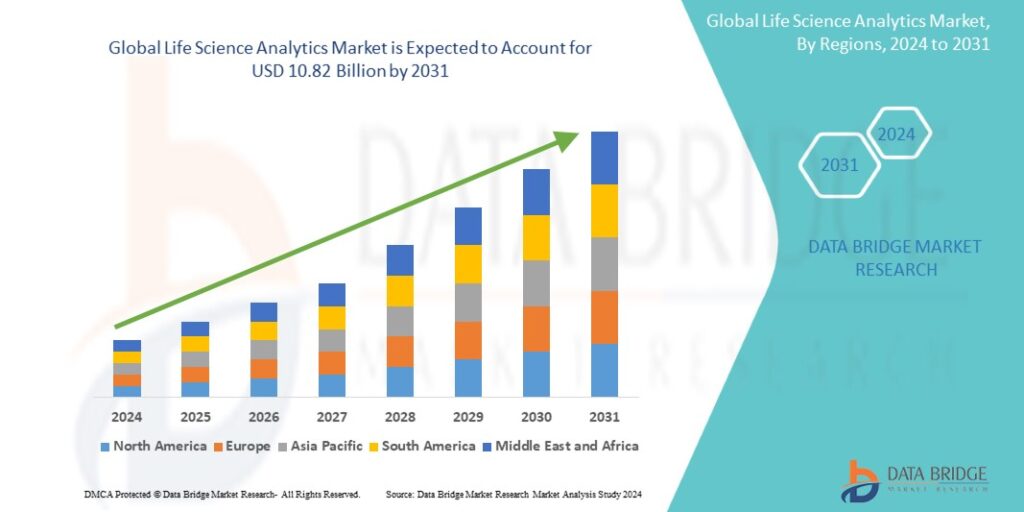Introduction
Life science analytics, a fusion of data science and life sciences, has emerged as a powerful tool for driving innovation and accelerating research. By leveraging advanced analytics techniques, life science organizations can extract valuable insights from vast datasets, optimize processes, and make data-driven decisions. This comprehensive overview explores the evolution of life science analytics, key market trends, factors driving its growth, and country-specific analysis.
Pharmacovigilance, within the realm of life science analytics market, encompasses the systematic monitoring, assessment, and prevention of adverse effects or any other drug-related problems. It employs sophisticated analytics tools and methodologies to gather, analyze, and interpret data from various sources such as clinical trials, post-marketing surveillance, and spontaneous reporting systems. These analytics help in identifying patterns, trends, and potential risks associated with pharmaceutical products, thereby ensuring the safety and efficacy of medications. Through advanced analytics, pharmacovigilance enables timely intervention, regulatory compliance, and informed decision-making by pharmaceutical companies, regulatory agencies, and healthcare providers, ultimately safeguarding public health.
Global life science analytics market size was valued at USD 5.80 billion in 2023 and is projected to reach USD 10.82 billion by 2031, with a CAGR of 8.1% during the forecast period of 2024 to 2031. In addition to the insights on market scenarios such as market value, growth rate, segmentation, geographical coverage, and major players, the market reports curated by the Data Bridge Market Research also include depth expert analysis, patient epidemiology, pipeline analysis, pricing analysis, and regulatory framework.
The Evolution of Life Science Analytics
The early days of life science analytics were characterized by simple statistical methods and manual data analysis. However, with advancements in technology, the field has undergone a significant transformation. The advent of high-performance computing, big data technologies, and machine learning algorithms has enabled life science organizations to process and analyze large volumes of complex data more efficiently.
Market Trends and Factors Driving Growth
Several factors are driving the growth of the life science analytics market:
- Increasing Data Volume and Complexity: The generation of vast amounts of data from genomics, proteomics, clinical trials, and electronic health records has created a need for advanced analytics tools to extract meaningful insights.
- Advancements in Technology: The development of cloud computing, artificial intelligence, and natural language processing has enabled life science organizations to leverage powerful analytics capabilities.
- Growing Focus on Precision Medicine: Precision medicine, which aims to tailor treatments to individual patients based on their genetic makeup and other factors, is driving the demand for life science analytics.
- Regulatory Pressures: Increasing regulatory requirements, such as those related to data privacy and security, are motivating life science organizations to invest in robust analytics solutions.
Country-Based Analysis
The life science analytics market is experiencing growth in various regions worldwide. North America and Europe have been traditional leaders, but Asia-Pacific is witnessing rapid growth due to increasing investments in research and development and the presence of major pharmaceutical and biotechnology companies. Countries such as China, India, and Japan are investing heavily in life science analytics infrastructure and talent, driving the market expansion.
Conclusion
Life science analytics has become an essential tool for driving innovation and accelerating research in the life sciences industry. By leveraging advanced analytics techniques, organizations can extract valuable insights from complex data, optimize processes, and make data-driven decisions. The continued growth of the life science analytics market is driven by factors such as increasing data volume, technological advancements, the focus on precision medicine, and regulatory pressures. As the field continues to evolve, life science organizations will need to embrace analytics to stay competitive and meet the challenges of the future.
Get More Detaill: https://www.databridgemarketresearch.com/reports/global-life-science-analytics-market



